Content
Varieties and types of aquilegia with a photo and a name are interesting to study for every enthusiastic florist. A herbaceous plant, with the right choice, can decorate the garden in style.
What does aquilegia look like
The aquilegia plant, known as the catchment and the eagle, is a perennial in the buttercup family. In height, it rises to an average of 1 m, the root is long, pivotal, with numerous branches. The flowering shoots are strong and branched, with a two-year development cycle; first, leaves sprout from the renewal bud at the base of the bush, which die off in the same autumn. The next year, a new root rosette is formed and a long stem rises. The leaves are large and wide, three times dissected.
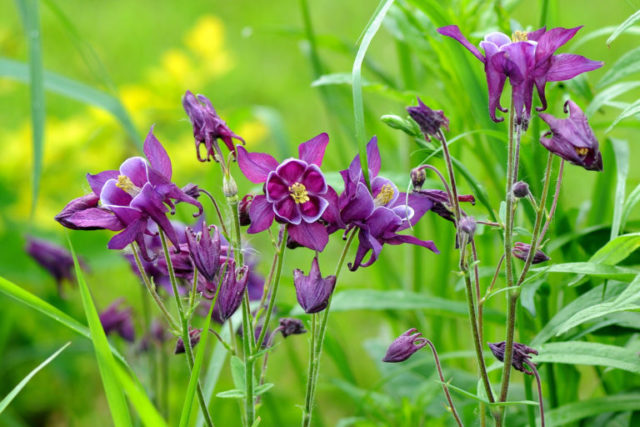
In total, there are more than 100 types of culture in the world, but only 35 are used for decorative purposes.
What do aquilegia flowers look like?
The catchment blooms mainly in May or June. During this period, the plant brings single buds - up to 12 pieces per peduncle. Inflorescences are paniculate, drooping and rare, the flowers themselves reach about 10 cm in width.
In the photo of the catchment flower, it can be seen that the bud is formed by a corolla of five petals arranged in the form of a funnel with an obliquely cut wide opening, and spurs - long outgrowths with a curved tip. The flowers can be white, blue, pink, orange and red in shade.
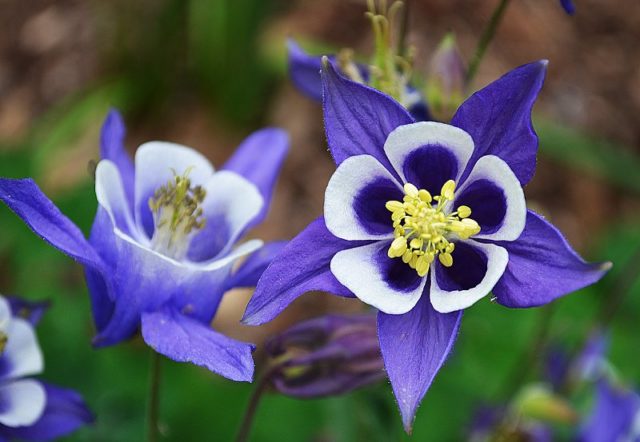
Elongated outgrowths at the ends of the aquilegia petals are called spurs.
The catchment blooms for about a month, after which a multileaf fruit with small black seeds ripens in place of the bud.
Varieties and types of aquilegia
The catchment is usually attributed to one of three varieties, within which there are numerous subspecies and varieties. Photos, descriptions and reviews of aquilegia distinguish European, American and Japanese groups.
European varieties
European is called an aquilegia with a spur, the edge of which is hooked. In addition, the group is characterized by a monochromatic color of the buds, which can be white, blue, blue and pink.
Ordinary
Common aquilegia (Latin Aquilegia vulgaris) is a natural species that is quite rare in Asia and Europe. The catchment looks like a medium-sized perennial 60-100 cm tall. The flowers have characteristic curved spurs and can be white, blue, light purple in color.
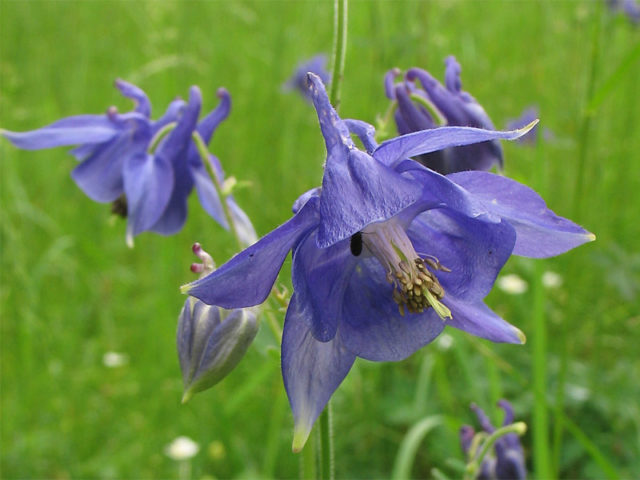
The common aquilegia blooms in May and remains decorative until July.
Alpine
Alpine catchment (Latin Aquilegia alpine) is found in the wild in the Alps in mountain meadows or forest glades. Under natural conditions, it grows 40 cm, blooms from June. The buds are blue or purple, with small curved spurs.
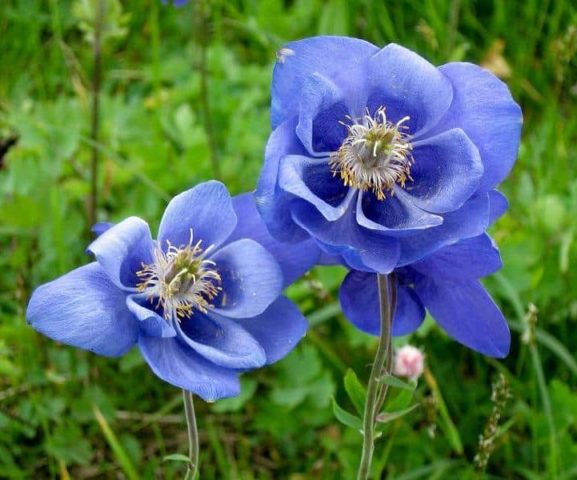
Alpine aquilegia bloom begins in June and lasts about a month.
Olympic
Olympic aquilegia (lat.Aquilegia olympica) grows abundantly in meadows and forests in Asia Minor and Iran. The perennial grows up to 60 cm, brings medium-sized flowers, mostly blue, but sometimes pink, with slight pubescence on the petals. The spurs of the Olympic catchment are short, curved, and the sepals are ovoid.
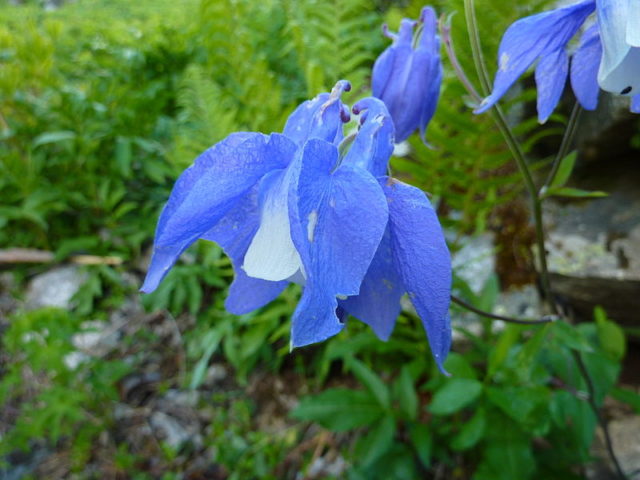
Basically, you can meet the Olympic aquilegia at an altitude of 3000 m above sea level
Glandular
Glandular aquilegia (Latin Aquilegia glandulosa) is widespread in the east of Siberia, Altai and Mongolia. It grows up to 70 cm above soil level, gives small, wide-open flowers with hooked spurs, most often blue, sometimes with a white border. Prefers to grow on wet soil, but it takes root well on stony soils.
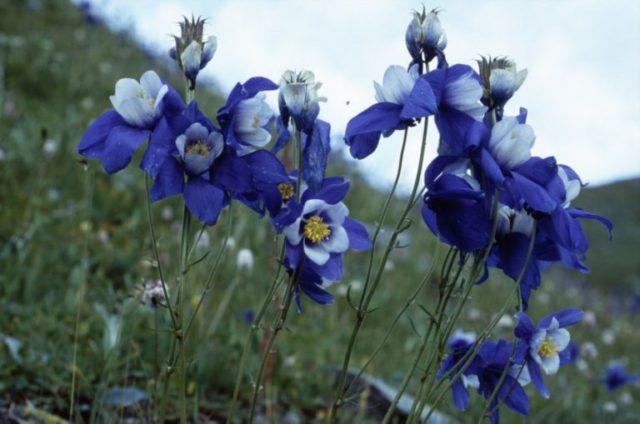
Ferruginous aquilegia grows mainly in Mongolia and Siberia
Fan-shaped (Akita)
In nature, fan-shaped aquilegia (Latin Aquilegia flabellata) can be found in northern Japan, on the Kuril Islands and Sakhalin. In rocks and mountains it grows scattered, in meadows and slopes it can spread very luxuriantly and abundantly. In height, the fan-shaped catchment can reach 60 cm, but sometimes it grows only up to 15 cm.
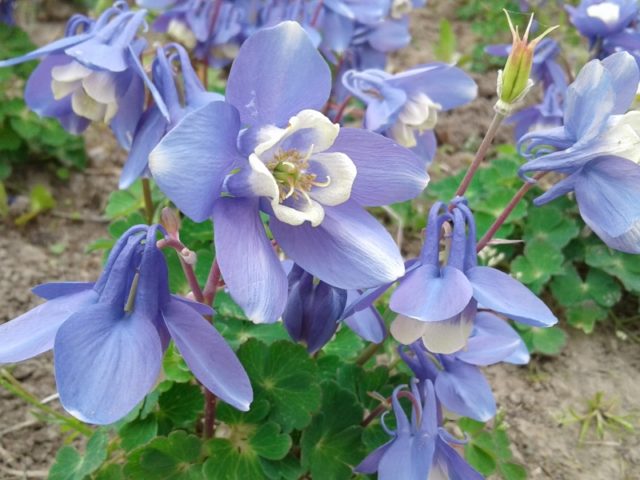
The fan-shaped catchment belongs to the European group, but grows in Japan and the Kuril Islands
Flowers are small, only up to 6 cm, with long hooked spurs. In shade, the buds are predominantly light purple with a white border.
Green-flowered
Green-flowered aquilegia (Latin Aquilegia viridiflora) grows in Mongolia, Eastern Siberia and China. In height it can reach from 25 cm to 60 cm. It blooms in early summer and brings rather unusual buds, they are green in color with a yellow edging. Like all European varieties, the green-flowered catchment has curved spurs.

Green-flowered aquilegia buds retain an unusual shade throughout flowering
Small-flowered
Small-flowered aquilegia (Latin Aquilegia parviflora) grows in Sakhalin and is very similar to the Akita variety, but brings smaller flowers, up to 3 cm in diameter. Prefers dry areas on stony mountain slopes, also found in sparse birch and mixed deciduous forests.
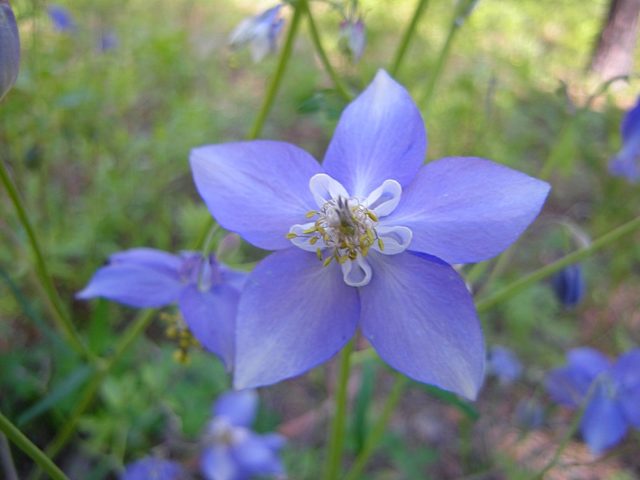
The buds of the small-flowered catchment are only 3 cm wide
In height, the small-flowered catchment reaches 50 cm, blooms with violet-blue buds with a short spur. In the period of decorativeness it begins in June or July, continues to bloom for about a month.
Siberian
In accordance with its name, Siberian aquilegia (Latin Aquilegia sibirica) grows in Western and Eastern Siberia, as well as in the Altai mountains. It can reach from 30 cm to 60 cm in height, depending on the conditions, the buds are small, about 5 cm.
The spurs of the Siberian aquilegia are thin and short, curved, the flowers are blue-lilac in shade, but sometimes they can be white or yellowish at the edges. The Siberian catchment becomes decorative at the end of May and continues to bloom for about 25 days.
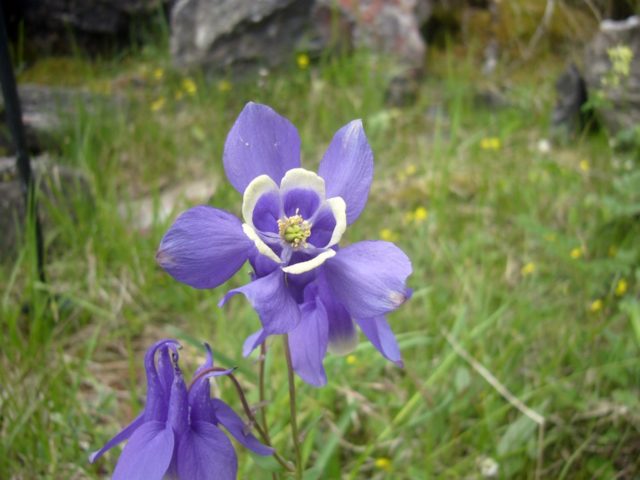
Siberian aquilegia has been cultivated for over two hundred years, since 1806
Acupressure
Ostrochalistikovaya aquilegia (Latin Aquilegia oxysepala) is common in Siberia, China, the Far East and Korea. It can grow up to 1 m, produces numerous side shoots on the stems. Brings small white or purple-yellow buds with short, up to 1 cm, curved spurs. The petals of the species are pointed at the tips, which explains the name. Ostrochalistikovy catchment blooms in June and July for 25 days.

Ostrochalistikovaya aquilegia prefers sunny areas with diffused shadow
Aquilegia Karelin
The Latin name for the variety is Aquilegia karelinii. It grows mainly in Central Asia, in the wooded areas of the Tien Shan. In height, it can rise up to 80 cm, brings purple or wine-red single buds up to 11 cm in diameter. The flower petals are truncated, the spurs are strongly curved and short.Flowering occurs in early June and lasts about 3 weeks.

Aquilegia Karelin differs from most European varieties in a wine-red hue
American varieties
The American catchment differs from other species in that its long spurs are straight, without noticeable bend. In addition, photos of species and varieties of aquilegia show that the group is characterized by a brighter color of flowers, there are red, golden and orange buds here.
Canadian
The Canadian catchment (Latin Aquilegia canadensis) is widespread in the east of North America in the mountains. The perennial can reach 90 cm in height, it brings medium-sized drooping buds - 2-3 pieces per stem.
The petals are red in color, with an orange corolla, the sepals are yellowish, and the straight long spur is reddish. The flowering of the Canadian aquilegia occurs in early summer and lasts 3 weeks.
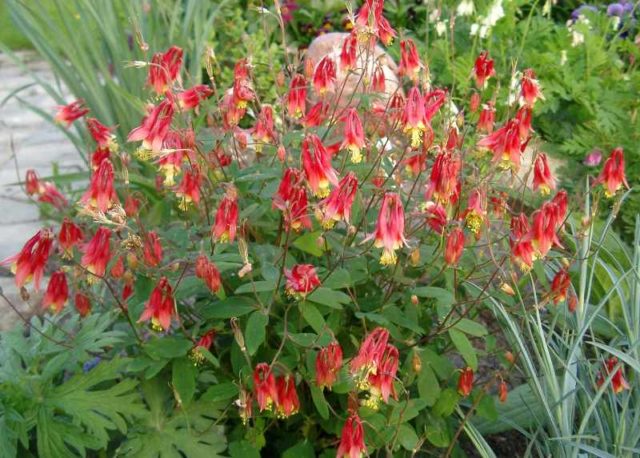
The buds of the canadian aquilegia grow up to 5 cm wide
Golden-flowered
The golden-flowered catchment (in Latin Aquilegia chrysantha) is common in northwestern Mexico. It grows freely both in high humidity and in mountainous areas, rises up to 1 m above the ground.
Flowering occurs in early summer. The plant produces medium-sized, bright yellow buds with thin, straight spurs.
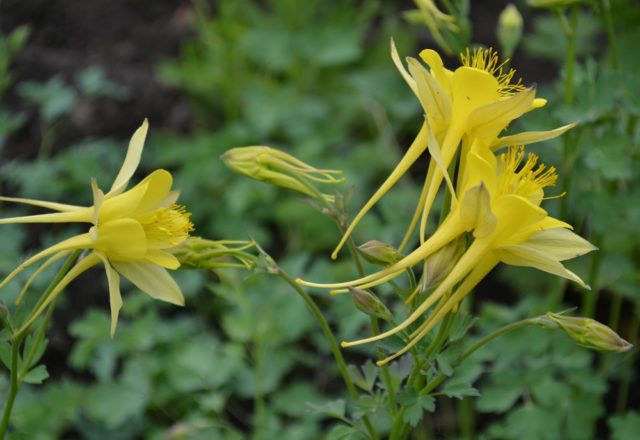
Spurs in golden-flowered aquilegia can reach 10 cm in length
Dark
Dark aquilegia (Latin Aquilegia atrata) grows wild mainly in Central Europe. The catchment can be seen in the mountain meadows of the Alps and Pyrenees, at an altitude of about 2000 m above sea level.
Dark aquilegia is a short plant and reaches 20-50 cm in height. The buds are also small, up to 5 cm in diameter with thin and short spurs. On one stem, there can be 3-10 flowers, their shade is red-purple. The period of decorativeness begins at the end of May and in June.

Dark aquilegia can grow on loamy soils
Skinner's Aquilegia
Skinner's catchment (in Latin Aquilegia skinneri) grows in the north of Mexico and on the Pacific coast of the American continent. Perennial grows up to 80 cm above the ground, gives drooping golden-yellow small flowers with orange-red sepals. The spurs of the species are long and straight, also orange-red. Flowering occurs in early summer and lasts 3 weeks.
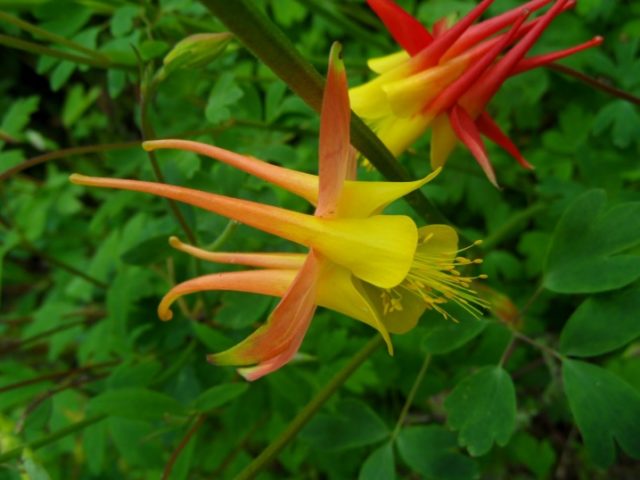
Skinner's Aquilegia produces buds about 4 cm in diameter with very long spurs
Blue
The blue catchment (from the Latin Aquilegia caerulea) grows in the rocky mountains of North America and reaches 80 cm above soil level. Differs in single or semi-double buds with white petals and pale blue sepals. From the photo and description of the aquilegia flowers, it can be seen that the spurs of the species are straight and thin, pale lilac, up to 5 cm in length.
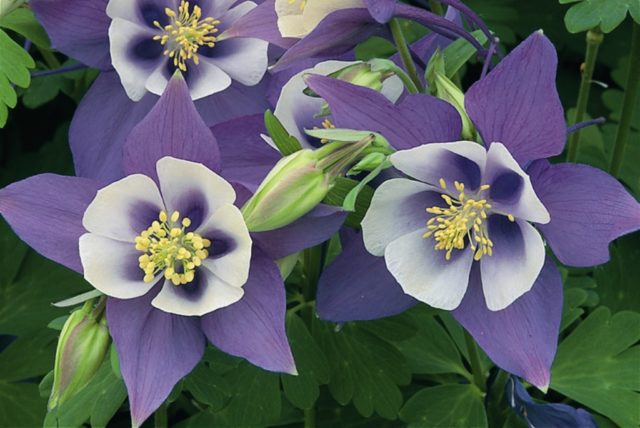
Blue aquilegia buds are about 6 cm wide
Spurless varieties (Japanese and Chinese)
Some types of aquilegia do not have a spur at all. They grow mainly in Japan, Central Asia, Korea and China. Since spurless species differ sharply from the European and American catchments, they are often found with the prefix "false" in the literature.
Pseudo-anemic watershed
The anemic paraquilegia (from the Latin Paraquilegia anemonoides) lives in rocky areas in Japan, China and Korea. The flowers of the pseudo-anemic collection are pale lilac, up to 4 cm wide, with bright orange stamens in the center. The plant has no spurs.
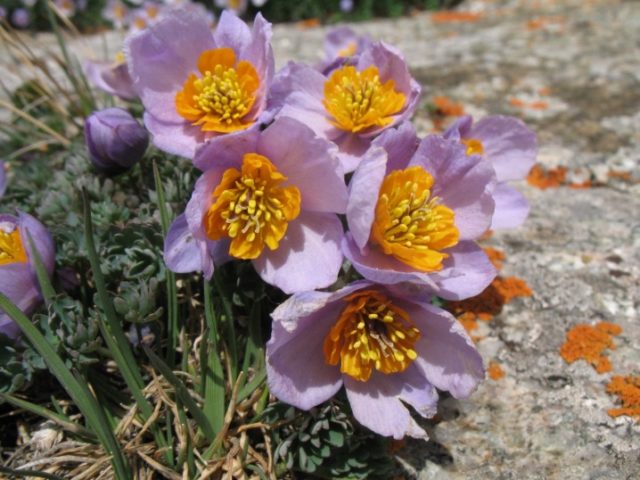
Anemone watershed grows well on rocky soils
Adoksovaya
Adox aquilegia (Latin Aquilegia adoxi-oides) is a low-growing perennial plant with a maximum height of about 30 cm. The buds are cuboid, with light purple petals. The variety does not have a spur, the flowers droop strongly on the stems.
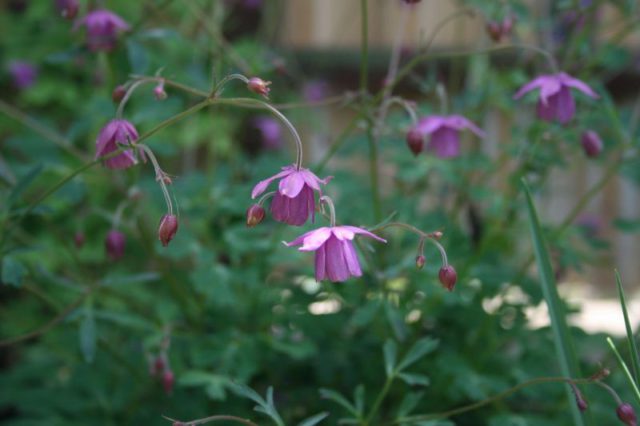
Adox, or adox-shaped aquilegia, is a variety with an interesting cube-shaped bud
Aquilegia spurless
Spurless aquilegia (from Latin Aquilegia ecalcarata) is a short perennial, only about 25 cm tall, growing in China and Japan. It blooms with small pink or lilac-red flowers. The plant has no spurs.
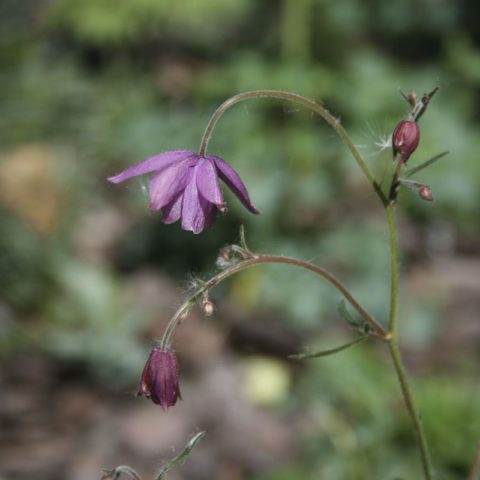
Spurless aquilegia blooms quite late - in July and August
Hybrid aquilegia
The main decorative value is represented by varieties of hybrid aquilegia (in Latin Aquilegia x hybrida) - cultivated varieties obtained as a result of selection. A hybrid catchment can be not only white, red, blue or cream, but also bicolor.
Biedermeier Series
Aquilegia Biedermeier is a series of varietal watersheds in blue, pink, red, white and other shades. Some flowers combine 2 tones at once, while others have the tips of the inner bright petals painted white.
Perennials reach about 35 cm in height and have good cold resistance up to -35 ° C. Flowering of the Biedermeier catchment occurs in May-June.
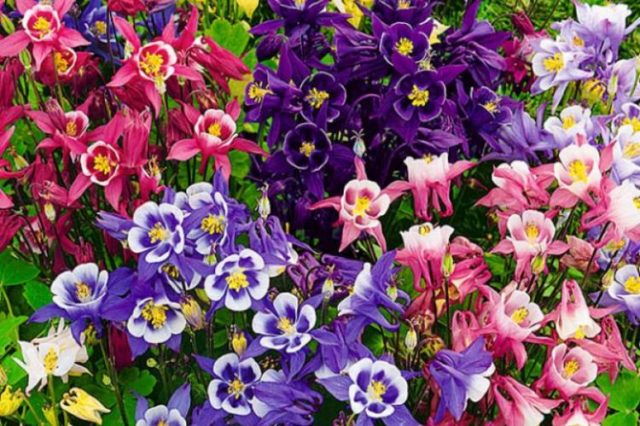
Aquilegia Biedermeier bred as a result of the selection of an ordinary catchment
Winky Series
Aquilegia Winky Mixed is a varietal mixture for growing in the garden and in flowerpots. The plants do not exceed 45 cm in height, flowering occurs in May and June. The buds of white, red, blue and purple shades do not droop, but look straight up. In structure, the flowers are double, which gives them an additional decorative effect.
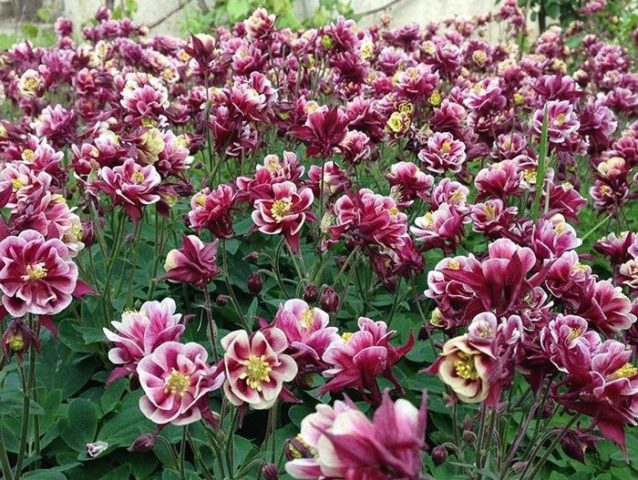
Aquilegia of the Winky series blooms with double buds
Spring Magic Series
Aquilegia of the Spring Magic series are well-developed tall hybrid perennials up to 70 cm in height and up to 1 m in diameter. The catchment of this series blooms profusely, with medium-sized snow-white and two-color buds - pink, blue, red, violet-white. It dissolves from June to August.
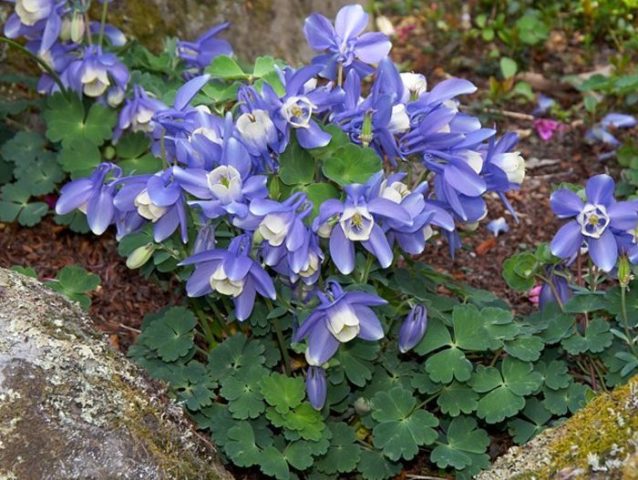
Spring Magic catchment is often planted among rocks
Clementine
Perennials from the Clementine series produce double salmon pink, white, purple and red buds. Plants are bred on the basis of the common catchment area, they differ from the wild-growing species in more lush flowers and a long period of decorativeness. In addition, according to the description of the aquilegia flower, the buds of the Clemenin series do not droop, but are directed vertically upward. Spurs are missing.
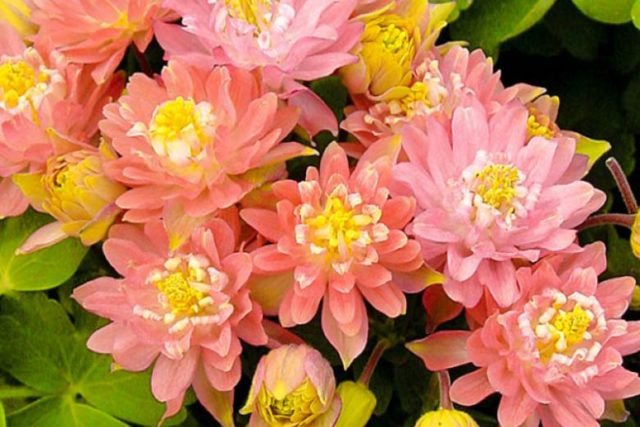
Aquilegia Clementine blooms in June and July
Columbine
The Columbine variety reaches 70 cm in height and pleases with a wide variety of colors and shades - white, pink, blue, red. The buds are collected in paniculate inflorescences; the catchment enters the maximum decorative effect at the end of May or in June.
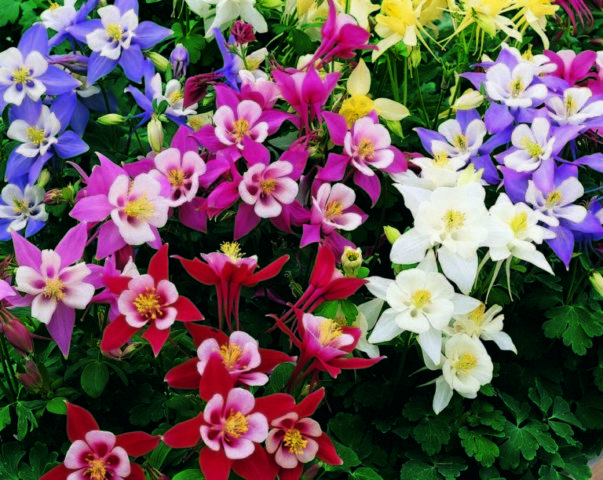
Aquilegia Columbina can grow in the sun and in shaded areas
Lime Sorbet
The Lime Sorbet variety is bred on the basis of ordinary aquilegia, reaches a height of 65 cm. In the photo of the plant, the catchment shows that the buds are double, drooping, at the beginning of flowering, pale green, and subsequently pure white. The variety has no spurs.
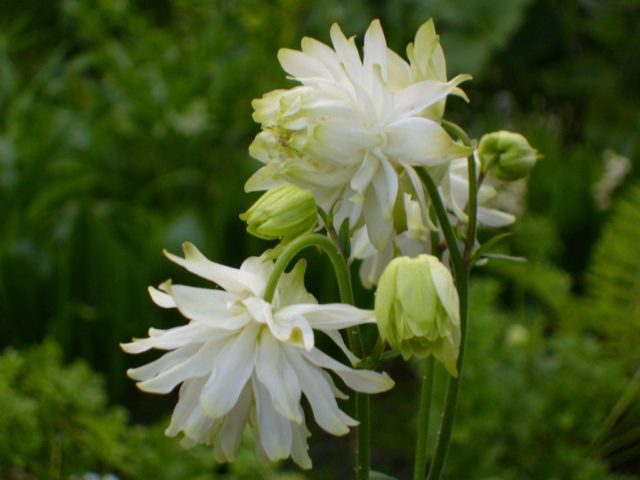
Lime Sorbet blooms in May and June
Adelaide Addison
Adelaide Addison belongs to the North American selection. Perennial bushes rise up to 60 cm, have fern-type leaves. The catchment begins to bloom in May, the buds are double, white at the top with a smooth transition to purple at the bottom.
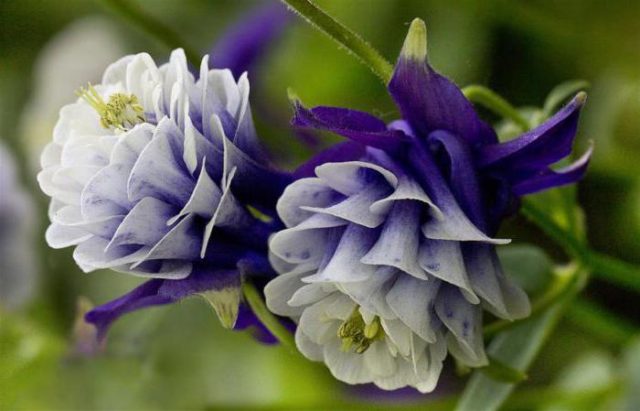
Adelaide Addison's white petals show blue "splashes"
Currant ice
Aquilegia Blackcurrant Ice is a dwarf variety and rises by an average of 15 cm. It blooms profusely in late May and early summer, producing buds with a creamy white center and purple underside.
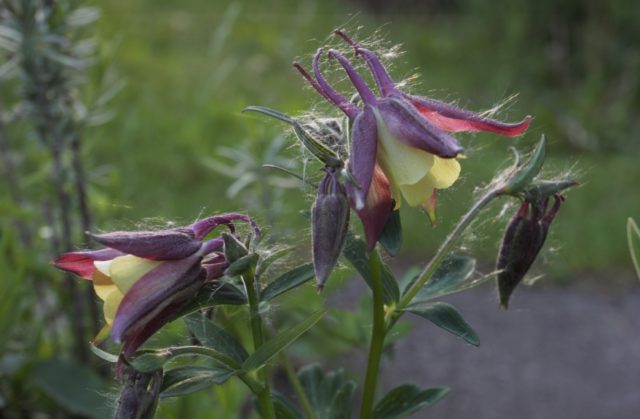
Variety Currant ice is planted in the sun and in partial shade
Ice blue
Blue Ice was developed from a fan-shaped catchment. The miniature plant rises an average of 12 cm, producing large buds 6 cm in diameter with a creamy top and a purple base. It blooms in June and July, takes root well in illuminated areas with light soil.
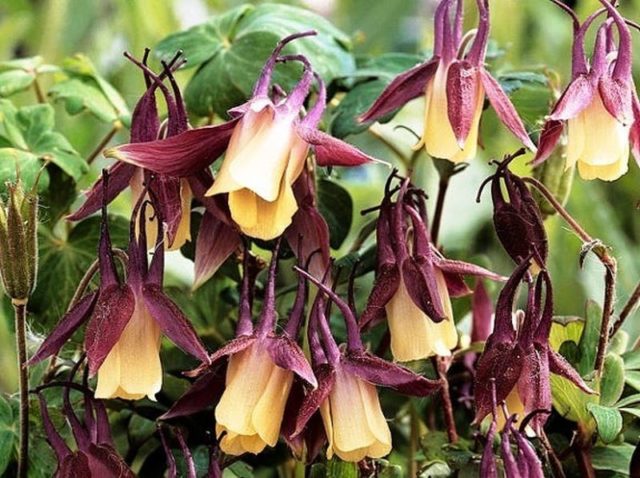
Contrary to its name, Blue Ice combines purple and cream colors
Yellow crystal
The catchment is a medium-sized hybrid up to 50 cm tall.In June and July, it blooms with bright yellow single buds with straight petals and a long, unbent spur. The characteristics and description of the Yellow Crystal aquilegia variety claim that the plant feels comfortable on humus soils in partial shade, prefers moderate humidity.

Aquilegia Yellow crystal - frost-resistant variety, wintering at -35 ° С
Chocolate Soldier
The Chocolate Soldier catchment is an unusual and rather rare variety, bred on the basis of green-flowered aquilegia. In height, it usually reaches no more than 30 cm, from May to July it brings buds - drooping bells of chocolate-purple color with brown spurs. The inflorescences consist of 3-7 flowers.

Chocolate Soldier buds emit a pleasant scent
Birds of paradise
Aquilegia Bird of Paradise, or Birds of Paradise, rises to 80 cm and blooms in double, loose buds of white, blue, red and pink shades. Due to the lush shape of the inflorescences, from the side it may seem that small beautiful birds are sitting on the shoots of the plant, this explains the name. The catchment reaches its maximum decorative effect in June-July, prefers sunny areas and partial shade for growth.

The Birds of Paradise variety is a frost-resistant plant that overwinters at temperatures below -30 ° С
Variety selection rules
Which catchment to buy for your own site depends solely on preferences. When studying photos and names of aquilegia varieties, you only need to pay attention to a few points:
- winter hardiness - most varieties tolerate frosts up to - 35 ° C, but this point is better to clarify when buying;
- soil and lighting requirements, some watersheds grow in shade and prefer loamy soil, others like sandy ground and sun;
- the color scheme, as shown by photos of aquilegia flowers in the garden, perennials should be combined with other plants and not look variegated against their background.

When grown in a garden, catchments can be combined with other plants and with each other
Conclusion
Varieties and types of aquilegia with a photo and a name allow you to appreciate the diversity of the herbaceous plant. Simple and hybrid catchments can beautify a garden if you choose the shades wisely.








